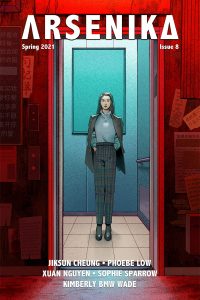Alexandra Pierce Reviews The Genesis of Misery by Neon Yang
 The Genesis of Misery, Neon Yang (Tor 978-1-25078-897-9, $27.99, 432pp, hc) September 2022. Cover by Angela Wang.
The Genesis of Misery, Neon Yang (Tor 978-1-25078-897-9, $27.99, 432pp, hc) September 2022. Cover by Angela Wang.
There’s a certain magic in using history in science fiction. Perhaps the most common option is alternative history. Another is what I think of as transposing history: taking what makes a sequence of historical events remarkable and moving them to a completely different setting, simultaneously keeping them recognizable and yet also creating a completely new story, one that exists in its own right.
In their debut novel The Genesis of Misery, Neon Yang takes the story of Joan of Arc and moves it from medieval France to a far-future, galactic empire. The nixen Misery Nomaki (she/they) is not the pious country girl that Joan is generally understood to have been: Misery grew up on a galactic backwater, yes, but she has nothing but contempt for her priest-brother Cremoline. Attempts to see her as (use her as) The Final Messiah are just convenient ways for her to get off said galactic backwater, as far as she is concerned. Like Joan, she hears angels; for Misery, it’s specifically one angel, name of Ruin – a hallucination that Misery fears is the beginning of madness, which is definitely not to be trusted, let alone listened to. Misery gets involved in battles with the royal family (there’s a rebellious princess rather than an uncrowned prince) and with the church, as Joan did, although often in rather different ways (see above, about lack of piety).
This empire Misery lives in was built by humans fleeing Earth. Their generation ship, then fifty generations old, was close to disaster when – three hundred years before our story – passengers aboard a tug, Misery’s Absolution, found a strange asteroid, had a revelation from the Demiurge (the Larex Forge, sometimes called God) – and also discovered holystone. Holy ruby, holy obsidian, holy jasper: they all have different properties, very useful for building a galactic empire, and those who are somehow changed by the Forge – able to survive on starlight alone – can interact with and manipulate it. So can Misery, even though she is not a saint. The first eight people to discover holystone become known as the Eight Messiahs – though two refused holiness and insisted there were technological explanations for what they were experiencing, thus spawning Heretics and a seemingly endless war. Now, Misery seems to be the Final Messiah, which just gets her into trouble, as people keep expecting things of her and she just wants to be left alone, to go – as she expects from familial history – quietly voidmad.
Yang is doing something quite different here from what they produced in their Tensorate series. Certainly there are similarities in theme: a concern around power – political and religious – and how it is used; a concern for the body, and physical experiences: the physical battles left me breathless, and the idea of a corridor having a ‘‘duodenal twist’’ is nauseating. Gender, too, is at the forefront, with every character introduced with their pronouns, because everyone provides that information in their public profile. However, differences in story are significant. On a prosaic level, where those novellas were set firmly on a planet, very little of the action here takes place dirtside; it’s mostly set on (admittedly enormous) space stations and in space, with all the differences in action that brings. In terms of story, this is much faster-paced than the Tensorate novellas tended to be; there’s a driving intensity to Misery herself and her conviction that she’s going ‘‘Void-mad,’’ as well as the collective fear (and experience) of battles with the Heretics. I enjoyed the Tensorate stories; I adored this.
A reader need not have any knowledge of Joan of Arc to enjoy The Genesis of Misery. The complexities of Misery as a character, the intricacies of the relationships she builds (generally fraught with suspicion), the space battles, and the depths of world building are all immensely rewarding in and of themselves. Knowing that there’s a Joan analogy – and knowing Joan’s own story – adds another layer: to be honest, it adds a layer of dread. When you know how Joan was eventually treated, you can’t help but worry for Misery. And yet there’s a fascination, too, as you keep wondering exactly how Yang will keep the historical and the fictional in balance. The answer is: beautifully.
This review was written on Wathaurong land.
Alexandra Pierce reads, writes, podcasts, cooks and knits; she’s Australian and a feminist. She was a host of the Hugo Award winning podcast Galactic Suburbia for a decade; her new podcast is all about indie bookshops and is called Paper Defiance. Alex has edited two award-winning non-fiction anthologies, Letters to Tiptree and Luminscent Threads: Connections to Octavia E Butler. She reviews a wide range of books at www.randomalex.net.
This review and more like it in the Sepetmber 2022 issue of Locus.
 While you are here, please take a moment to support Locus with a one-time or recurring donation. We rely on reader donations to keep the magazine and site going, and would like to keep the site paywall free, but WE NEED YOUR FINANCIAL SUPPORT to continue quality coverage of the science fiction and fantasy field.
While you are here, please take a moment to support Locus with a one-time or recurring donation. We rely on reader donations to keep the magazine and site going, and would like to keep the site paywall free, but WE NEED YOUR FINANCIAL SUPPORT to continue quality coverage of the science fiction and fantasy field.
©Locus Magazine. Copyrighted material may not be republished without permission of LSFF.








